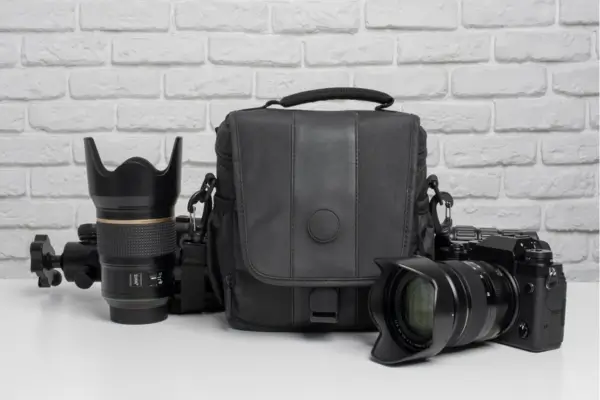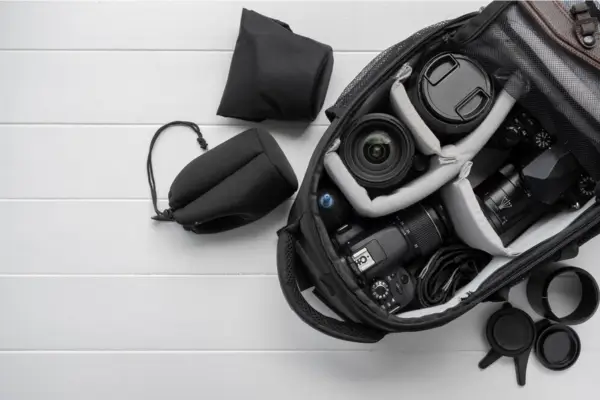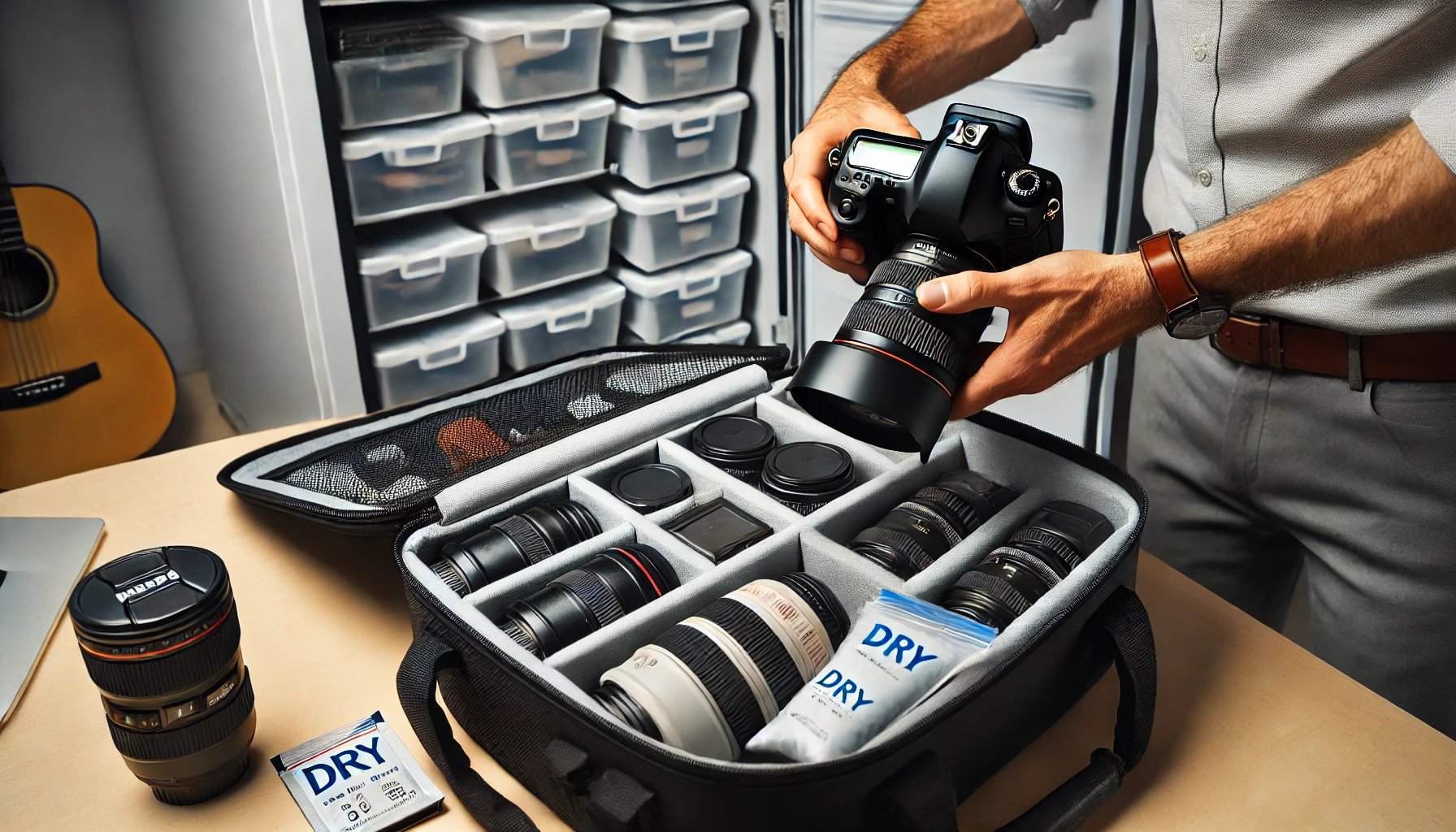Photography gear is a significant investment, and taking proper care of it ensures that your equipment remains in excellent condition for years to come. Whether you’re a professional photographer or a hobbyist, knowing how to store and protect your camera, lenses, and accessories is essential to maintain their performance and longevity.
Improper storage can lead to various issues, such as dust accumulation, moisture damage, and even mechanical failures. Leaving your camera gear exposed to extreme temperatures, humidity, or physical impact can result in costly repairs or permanent damage. Additionally, poor organization increases the risk of accidental drops or scratches, reducing the overall lifespan of your equipment.
In this article, we will cover the best practices for storing and protecting your photography gear. From choosing the right storage solutions to preventing environmental and physical damage, we’ll provide expert tips to help you keep your equipment safe. Whether you’re at home, in a studio, or traveling, these strategies will ensure that your gear stays in top condition and ready for your next shoot.
Choosing the Right Storage Solutions
Properly storing your photography gear is essential to maintaining its longevity and performance. Choosing the right storage solutions depends on factors like your shooting environment, travel needs, and the type of equipment you own. Below, we explore different options to help you make the best choice.
Hard Cases vs. Soft Bags: Pros and Cons
When selecting storage for your gear, you’ll need to decide between hard cases and soft bags. Each has its advantages and disadvantages:
🔹 Hard Cases
✅ Superior protection against physical damage (impacts, drops, and crushing)
✅ Waterproof and dustproof options available
✅ Secure locking mechanisms for added security
❌ Heavier and bulkier, making them less convenient for travel
❌ Generally more expensive than soft bags
🔹 Soft Bags
✅ Lightweight and easier to carry
✅ More flexible in terms of storage compartments and accessibility
✅ More affordable than hard cases
❌ Less protection against impact and extreme weather conditions
❌ Not always waterproof or dust-resistant
If you frequently travel with your gear or shoot in rugged conditions, a hard case may be the better option. However, for casual use or everyday photography, a soft bag provides convenience and flexibility.
Climate-Controlled Storage for Long-Term Gear Protection
Temperature and humidity play a crucial role in protecting your photography gear from damage. High humidity levels can lead to mold and fungus growth on lenses, while extreme temperatures can affect battery performance and damage camera sensors.
Here’s how to protect your equipment in long-term storage:
- Use a dehumidifier or dry cabinet to maintain optimal humidity levels (between 35%-45%).
- Store gear in a cool, dry place, away from direct sunlight and fluctuating temperatures.
- Add silica gel packs inside storage bags or cases to absorb excess moisture.
- Avoid attic and basement storage, as these areas often have inconsistent temperature and humidity levels.
Investing in a dry cabinet is an excellent option for photographers who store their gear for extended periods, especially in humid environments.
Organizing Your Gear Efficiently to Avoid Damage
Proper organization not only protects your equipment but also makes it easier to find what you need quickly. Follow these tips to keep your photography gear safe and accessible:
- Use padded dividers inside bags or cases to prevent lenses and cameras from knocking against each other.
- Label compartments or use color-coded pouches for memory cards, batteries, and small accessories.
- Wrap cables properly to prevent tangling and breakage.
- Keep lens caps and body caps on when storing cameras and lenses to avoid dust buildup.
- Regularly clean and inspect your storage setup to ensure everything remains in top condition.
By selecting the right storage solution and maintaining an organized system, you can keep your photography gear protected and ready for your next shoot.

Protecting Your Camera and Lenses from Environmental Factors
Photography gear is highly sensitive to environmental conditions. Factors like humidity, temperature fluctuations, dust, and dirt can significantly impact the performance and longevity of your camera and lenses. Here’s how to properly protect your equipment from these elements.
Humidity Control: Using Silica Gel and Dehumidifiers
Excess humidity is one of the biggest threats to camera gear, as it can lead to fungus growth inside lenses and cause corrosion in electronic components. To control humidity:
- Use silica gel packets inside your camera bag or storage case to absorb excess moisture. Replace them regularly to ensure effectiveness.
- Invest in a dehumidifier if you live in a humid climate. A small electronic dehumidifier in your storage space can help maintain optimal conditions.
- Store gear in a dry cabinet designed for cameras. These cabinets have adjustable humidity controls to prevent moisture damage.
Temperature Considerations: Avoiding Extreme Heat and Cold
Extreme temperatures can cause condensation, battery drain, and even sensor damage. Follow these precautions:
- Avoid leaving your gear in direct sunlight or inside a hot car, as excessive heat can warp plastic components and damage the sensor.
- Acclimate your camera gradually when moving from a cold to a warm environment. Place it inside a sealed bag to prevent condensation from forming inside the lens and body.
- Store batteries separately in a temperature-controlled environment, as extreme cold can reduce battery life and performance.
Protection Against Dust and Dirt: Proper Sealing and Cleaning
Dust and dirt can scratch your lenses and interfere with camera functions, so keeping your gear clean and properly sealed is crucial:
- Use a weather-sealed camera bag to protect your gear from dust, sand, and debris, especially when shooting in outdoor environments.
- Keep lens caps and body caps on when your camera is not in use to prevent particles from settling on sensitive components.
- Clean your camera and lenses regularly using a soft brush, air blower, and microfiber cloth to remove dust without scratching the surfaces.
By implementing these protective measures, you can ensure that your photography gear remains in top condition, delivering high-quality images for years to come.
Preventing Physical Damage
Photography gear is a significant investment, and even minor physical damage can lead to costly repairs or irreversible deterioration. To ensure your camera and accessories remain in top condition, follow these best practices for handling and transporting your gear safely.
Best Practices for Handling and Transporting Your Gear
- Use a Dedicated Camera Bag: Invest in a high-quality, padded camera bag or backpack designed specifically for photography equipment. These bags provide proper compartments and shock-absorbent materials to prevent accidental damage.
- Secure Your Gear When Traveling: Whether you’re commuting to a local shoot or flying to a distant location, always ensure your gear is securely packed. Use TSA-approved locks for added security and avoid placing heavy objects on top of your camera bag.
- Be Mindful When Changing Lenses: Always switch lenses in a clean, dry area to prevent dust and dirt from entering the camera sensor. Hold the camera facing downward to minimize exposure and store unused lenses with their caps on.
- Use a Camera Strap: A sturdy, comfortable camera strap reduces the risk of accidental drops. Consider a cross-body or wrist strap for additional security, especially in crowded or active shooting environments.
Using Padded Dividers and Lens Caps for Extra Protection
Properly storing your camera and accessories inside your bag is just as important as using the right bag itself. Here are some key tips to maximize protection:
- Utilize Padded Dividers: Adjustable padded dividers help keep your camera, lenses, and other accessories from moving around inside your bag. This reduces the risk of collisions that could cause internal or external damage.
- Keep Lens Caps On: Always cover your lenses with their front and rear caps when not in use. This prevents scratches, dust accumulation, and accidental smudging.
- Wrap Delicate Accessories: Items like external hard drives, filters, and flashes should be stored in separate padded compartments or protective cases to prevent impact damage.
Avoiding Common Mistakes That Lead to Scratches and Cracks
- Placing the Camera on Rough Surfaces: Always place your camera on a clean, stable surface to avoid scratches on the body and LCD screen. Consider using a microfiber cloth or camera base plate for added protection.
- Forgetting to Secure Zippers and Latches: Ensure that your camera bag is fully zipped and latched before moving. A partially open bag can lead to accidental drops or exposure to dirt and moisture.
- Neglecting to Store Gear After Use: Leaving your camera out in an unprotected space increases the risk of accidental knocks, dust buildup, and exposure to potential spills. Always return it to its designated storage area when not in use.
- Overloading Your Camera Bag: Carrying too much gear in one bag can put unnecessary pressure on your equipment. Make sure each item has its designated space and avoid overstuffing compartments.
By following these precautions, you can significantly extend the lifespan of your photography gear and ensure that it remains in peak condition for years to come.

Security Measures to Prevent Theft
Protecting your photography gear from theft is just as important as safeguarding it from physical and environmental damage. High-quality camera equipment is valuable and often a target for thieves, whether at home, in a studio, or while traveling. Implementing the right security measures can help prevent loss and give you peace of mind.
Using Lockable Storage Cases and Safes
One of the best ways to secure your photography gear at home or in a studio is by using lockable storage solutions. Hard cases with built-in locks, such as Pelican or Vanguard cases, offer durable protection against both theft and accidental damage. These cases are designed with reinforced exteriors and customizable foam interiors to keep your equipment safe and well-organized.
For even greater security, consider investing in a fireproof and waterproof safe. A high-quality safe not only protects your gear from potential theft but also shields it from unexpected disasters such as fires or floods. Look for safes with biometric or combination locks for enhanced security.
Travel Safety: How to Secure Your Gear on the Go
When traveling with your photography equipment, extra precautions are necessary to minimize the risk of theft. Here are some essential tips:
- Use an Inconspicuous Bag: Avoid camera bags that scream “expensive gear inside.” Instead, opt for a regular backpack with padded inserts to keep your gear hidden and protected.
- Keep Gear with You: Never check in your camera equipment at airports. Carry it as a personal item to prevent damage and theft.
- Use Anti-Theft Accessories: Consider anti-theft backpacks with lockable zippers and slash-proof materials. Additionally, cable locks can secure your gear when left unattended in hotel rooms or cafés.
- Be Mindful in Crowded Areas: Thieves often target photographers in busy tourist spots. Keep your camera strap secured around your wrist or neck and be aware of your surroundings.
- Use GPS Trackers: Small tracking devices like Apple AirTags or Tile trackers can be placed inside camera bags or attached to valuable equipment to help locate them in case of loss or theft.
Insurance Options for Photography Equipment
Even with the best security measures, theft can still happen. Having the right insurance policy can save you from a significant financial loss. Consider these options:
- Homeowner’s or Renter’s Insurance: Some policies may cover photography gear, but coverage might be limited. Check with your provider to see if additional coverage is needed.
- Specialized Photography Insurance: Companies offer tailored insurance for photographers that cover theft, accidental damage, and even liability. This is especially useful for professionals.
- Travel Insurance: If you frequently travel with your gear, look for a travel insurance plan that includes coverage for lost or stolen photography equipment.
By implementing these security measures, you can significantly reduce the risk of theft and ensure that your valuable photography gear stays protected no matter where you go.

Regular Maintenance and Cleaning
Proper maintenance and regular cleaning are essential to keep your photography gear in top condition. Dust, dirt, and moisture can accumulate over time, affecting performance and image quality. Here’s how to ensure your camera, lenses, and accessories stay in optimal shape.
How to Clean Your Camera, Lenses, and Accessories Properly
Keeping your gear clean prevents long-term damage and ensures consistently sharp images. Follow these best practices:
- Camera Body: Use a soft microfiber cloth to wipe the exterior and remove dust and smudges. For stubborn dirt, slightly dampen the cloth with a small amount of lens-cleaning solution.
- Sensor Cleaning: If you notice spots on your images, your sensor may have dust particles. Use an air blower to remove loose debris. For deeper cleaning, use a sensor-cleaning kit or seek professional servicing.
- Lenses: Always use a lens blower or brush to remove dust before wiping with a microfiber cloth. Apply a few drops of lens-cleaning fluid to the cloth (not directly on the lens) and wipe gently in a circular motion. Avoid excessive pressure to prevent scratches.
- Lens Filters and Accessories: Clean filters using the same technique as lenses. Wipe camera straps and bags occasionally to prevent dirt buildup.
Storing Batteries and Memory Cards Safely
Improper storage of batteries and memory cards can lead to data loss or battery failure. Keep these tips in mind:
- Batteries: Store them in a cool, dry place, away from direct sunlight and heat sources. If not using your camera for an extended period, remove the battery to prevent leakage. Avoid storing fully charged or fully drained batteries for long periods—keep them around 40-50% charge.
- Memory Cards: Keep memory cards in protective cases to prevent dust, static, and physical damage. Format them regularly within your camera (not on a computer) to maintain performance and prevent corruption. Avoid exposing memory cards to moisture or extreme temperatures.
Scheduling Maintenance Checks for Long-Term Performance
Regular checkups help identify potential issues before they become major problems. Here’s how to maintain your gear for the long run:
- Monthly Inspections: Check for dust buildup, scratches, or loose parts on your camera body and lenses. Clean your equipment and test all functions to ensure everything is working properly.
- Yearly Professional Servicing: Consider taking your camera and lenses to a professional technician for deep cleaning and calibration. This is especially important for photographers who shoot in challenging environments like beaches, deserts, or humid conditions.
- Firmware Updates: Regularly check for firmware updates from your camera manufacturer. Keeping your camera’s software up to date can improve performance and fix potential issues.
By following these maintenance and cleaning tips, you can extend the lifespan of your photography gear and ensure it performs at its best for years to come. Investing time in proper care will save you money in repairs and replacements while keeping your shots crisp and clear.
Conclusion
Properly storing and protecting your photography gear is essential to maintaining its longevity and performance. By choosing the right storage solutions, controlling environmental factors, preventing physical damage, implementing security measures, and conducting regular maintenance, you can keep your equipment in top condition for years to come.
Investing in high-quality storage cases, using dehumidifiers to prevent moisture damage, and handling your gear with care can save you from costly repairs or replacements. Additionally, securing your equipment at home and while traveling ensures that your valuable gear stays safe from theft and accidental damage.
Now that you have these essential tips, it’s time to put them into practice! Do you have any personal strategies or favorite storage solutions for keeping your photography gear safe? Share your tips and experiences in the comments below—we’d love to hear from you!
